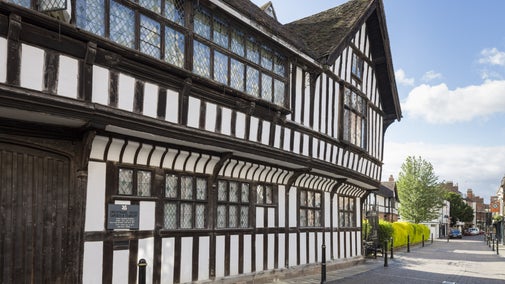
Greyfriar's House and Garden collections
Explore the objects and works of art we care for at Greyfriars House and Garden on the National Trust Collections website.

Our understanding of the history of Greyfriars is the result of decades of meticulous research and analysis. The name ‘Greyfriars’ is actually a misnomer. When the building was rescued from demolition and restored in the mid-20th century, it was believed to have been a surviving part of a Franciscan Friary which had once stood next door (the friars were of the Franciscan order and wore grey habits, hence they were known locally as ‘The Greyfriars’.)
In the 1980s the National Trust commissioned local historian Pat Hughes to carry out an in-depth survey of the building’s history, based upon archival evidence available from the city records office. From this it was deduced that the origins of Greyfriars lay in the late 15th century, built for a wealthy city merchant and twice-High Bailiff of Worcester, Thomas Green.
In spite of the new information the name Greyfriars has stuck. Until 2016 the house was tentatively dated to 1485, based upon interpretation of its architecture. In 2015 the Worcestershire Archaeological Society funded a program of dendro-chronology, analysing core samples taken from the ancient timbers of the property. These revealed that the earliest timbers were felled in the year 1489 – so the architectural historians weren’t too far off the mark after all.

Further research carried out has since uncovered a wealth of fascinating history written in to the very fabric of the building which tells a story of changing fortunes. Greyfriars has been home to some of Worcester’s most infleuntial and wealthy citizens, alongside some of its poorest and most destitute. It has shared a boundary wall with respected ecclesiastic figures, and later with criminals and vagabonds. It has witnessed first-hand the rage of battle – both in the civil war and later in the fight to save Worcester’s ancient architecture from disastrous town planning.

Greyfriars passed in to the care of the National Trust in 1966, but the preservation of the building, its restoration and present appearance are owed to just a handful of individuals who fought to save the building from demolition earlier in the 20th century.
In 1936 Greyfriars was served with a compulsory demolition order by Worcester City Corporation. The building had been gradually decaying for decades and was all but abandoned by its inhabitants at that time. The outbreak of the Second World War in 1939 disrupted demolition plans and in 1943 the president of the Worcestershire Archaeoloigcal Society (WAS), Major W.J. Thompson purchased the property and set about making emergency structural repairs.
With the building structurally secured, it was passed in to the care of the WAS who debated how best to complete the work of Major Thompson. A long-term solution was found in 1949 when two members, siblings Elsie and Matley Moore proposed to complete the restoration and refurbishment at their own expense in exchange for life-long tenancy.
Between 1949 and their respective deaths in the mid-1980s, Elsie and Matley lovingly restored the building to give it its present eclectic appearance. At a time when Britain was demolishing much of its heritage, the Moores found rich pickings in salvagable historic fabric and took full advantage.
Many of the objects in the collection comprise discarded historic materials, given a new lease of life in a process that would probably be recognised as ‘upcycling’ today.
The result is a unique home filled with fascinating curios, where every object has its own story to tell. Combine this with the storied history of property, and you can be sure of a unforgettable experience at Greyfriars.

Explore the objects and works of art we care for at Greyfriars House and Garden on the National Trust Collections website.

Late medieval merchant's house, rescued from demolition, in Worcester city centre

The walled garden pays homage to what stood before, a row of 10 houses, demolished and rebuilt as a tranquil outdoor space in the heart of the city.

Join us at Friar Street for an eye-opening tour, where we’ll uncover the misnomer that is Greyfriars and reveal hidden stories from over 500 years of history. Local items can tell a story about a house, its people, history and traditions. See the items salvaged and restored by the Moore siblings who owned the house. Here's a taster of treasures to look out for on your visit.

Learn about people from the past, discover remarkable works of art and brush up on your knowledge of architecture and gardens.